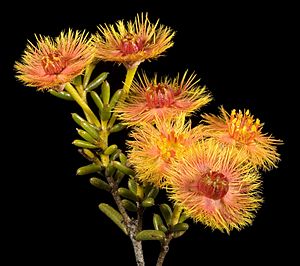Yellow featherflower facts for kids
Quick facts for kids Yellow featherflower |
|
|---|---|
 |
|
| V. chrysantha in Kalbarri National Park | |
 |
|
| Scientific classification | |
| Genus: |
Verticordia
|
| Species: |
chrysantha
|
The Verticordia chrysantha, often called the yellow featherflower or yellow Morrison, is a beautiful flowering plant. It belongs to the myrtle family, called Myrtaceae. This plant is special because it only grows in Western Australia. It's a small, bushy shrub that grows slowly. Its bright yellow flowers often change to a reddish-brown color as they get older. You can find this plant in many parts of the south-west of Western Australia.
Contents
What Does the Yellow Featherflower Look Like?
The yellow featherflower is a shrub that can grow from about 15 centimeters (6 inches) to 1.5 meters (5 feet) tall. Sometimes, it can be almost as wide as it is tall. It has one main stem that branches out.
Its leaves are long and thin, like a line. They are round when you look at them from the end, and they are usually between 3 and 15 millimeters (0.1 to 0.6 inches) long. Each leaf has a pointy tip, which sometimes has a small hook.
The flowers often smell nice. They grow in groups at the ends of the branches, looking a bit like a flat-topped cluster. They are bright yellow when they first bloom, but as they age, their centers might turn bronze or brown. Each flower stands up straight on a stalk that is 4 to 18 millimeters (0.2 to 0.7 inches) long.
The bottom part of the flower, called the floral cup, looks like half a sphere. It's about 1.5 millimeters (0.06 inches) long and has 10 small ridges. It's smooth and a little bumpy. The sepals, which are like small leaves that protect the flower bud, are bright yellow and about 4.0 to 4.5 millimeters (0.16 to 0.18 inches) long. They have 7 to 10 feathery parts.
The petals, which are the main colorful parts of the flower, are also bright yellow and shaped like an egg. They are about 3.5 to 5.0 millimeters (0.14 to 0.20 inches) long and have long, finger-like parts that spread out. The style, which is part of the female reproductive organ of the flower, is 3.5 to 4 millimeters (0.14 to 0.16 inches) long and can be straight or slightly curved. These beautiful flowers bloom from September to December.
How Did it Get its Name?
The yellow featherflower was first officially described in 1838 by a scientist named Stephan Endlicher. He wrote about it in a book called Stirpium Australasicarum Herbarii Hugeliani Decades Tres. The plants he studied were collected by John Gilbert in 1842.
The plant's scientific name, chrysantha, comes from two old Ancient Greek words. Khrusos means "gold," and anthos means "flower." So, chrysantha simply means "gold flower," which perfectly describes its bright yellow color!
In 1991, another scientist named Alex George studied the whole group of Verticordia plants. He placed the yellow featherflower in a smaller group called Chrysoma, and then in an even smaller group called Jugata. Other plants in this group include V. chrysanthella, V. brevifolia, and V. galeata.
Where Does the Yellow Featherflower Grow?
This type of verticordia plant can be found in many different kinds of soil and plant areas. It grows between Kalbarri in the north-west and Esperance on the south coast of Western Australia. However, you won't find it in the very far south-west corner of the state.
Is the Yellow Featherflower Protected?
Good news! The Verticordia chrysantha is not considered to be in danger. The Western Australian Government's Department of Parks and Wildlife has classified it as "not threatened." This means there are enough of these plants in the wild, and they are not at risk of disappearing.
Growing Yellow Featherflowers in Gardens
The yellow featherflower is a popular plant for gardens, even though it grows slowly. It usually needs to be replaced after about 5 years. For the best results in a garden, it should be planted in soil that drains water well and gets lots of sunshine. This plant is also known to be good at handling dry conditions, so it doesn't need a lot of water once it's established.
When many yellow featherflowers are planted together, they create a very attractive display. Scientists have also found that if you bury the seeds in soil for a year and then treat them with smoke, they are more likely to sprout and grow.


